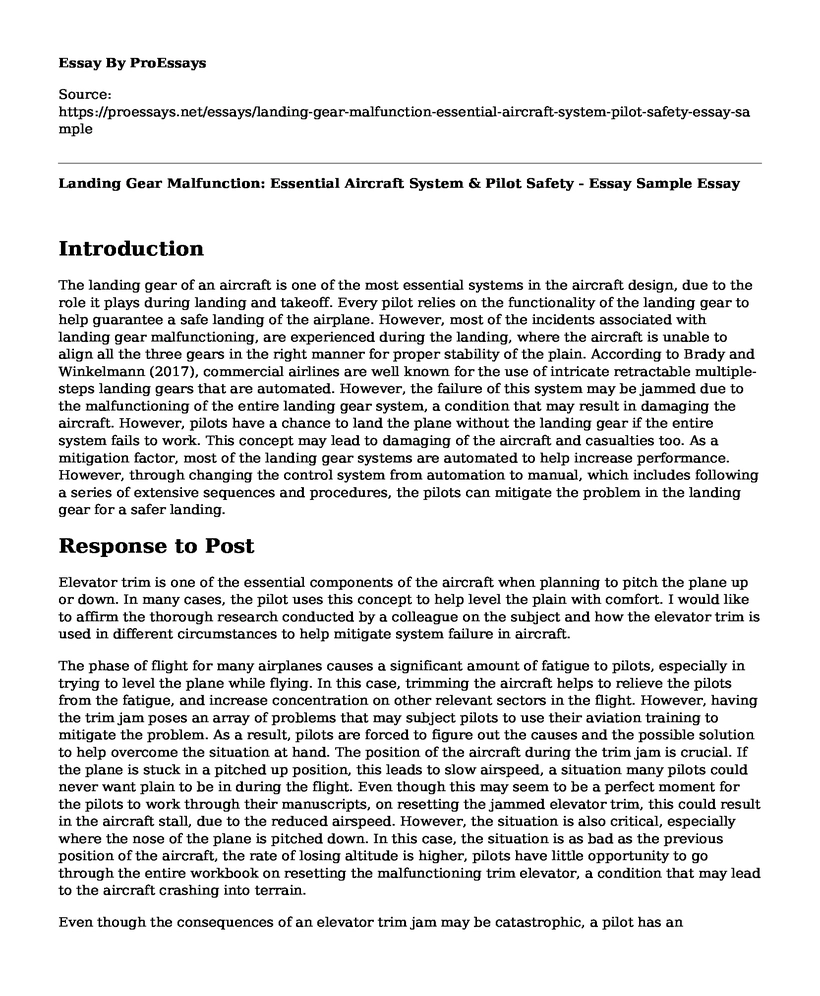Introduction
The landing gear of an aircraft is one of the most essential systems in the aircraft design, due to the role it plays during landing and takeoff. Every pilot relies on the functionality of the landing gear to help guarantee a safe landing of the airplane. However, most of the incidents associated with landing gear malfunctioning, are experienced during the landing, where the aircraft is unable to align all the three gears in the right manner for proper stability of the plain. According to Brady and Winkelmann (2017), commercial airlines are well known for the use of intricate retractable multiple-steps landing gears that are automated. However, the failure of this system may be jammed due to the malfunctioning of the entire landing gear system, a condition that may result in damaging the aircraft. However, pilots have a chance to land the plane without the landing gear if the entire system fails to work. This concept may lead to damaging of the aircraft and casualties too. As a mitigation factor, most of the landing gear systems are automated to help increase performance. However, through changing the control system from automation to manual, which includes following a series of extensive sequences and procedures, the pilots can mitigate the problem in the landing gear for a safer landing.
Response to Post
Elevator trim is one of the essential components of the aircraft when planning to pitch the plane up or down. In many cases, the pilot uses this concept to help level the plain with comfort. I would like to affirm the thorough research conducted by a colleague on the subject and how the elevator trim is used in different circumstances to help mitigate system failure in aircraft.
The phase of flight for many airplanes causes a significant amount of fatigue to pilots, especially in trying to level the plane while flying. In this case, trimming the aircraft helps to relieve the pilots from the fatigue, and increase concentration on other relevant sectors in the flight. However, having the trim jam poses an array of problems that may subject pilots to use their aviation training to mitigate the problem. As a result, pilots are forced to figure out the causes and the possible solution to help overcome the situation at hand. The position of the aircraft during the trim jam is crucial. If the plane is stuck in a pitched up position, this leads to slow airspeed, a situation many pilots could never want plain to be in during the flight. Even though this may seem to be a perfect moment for the pilots to work through their manuscripts, on resetting the jammed elevator trim, this could result in the aircraft stall, due to the reduced airspeed. However, the situation is also critical, especially where the nose of the plane is pitched down. In this case, the situation is as bad as the previous position of the aircraft, the rate of losing altitude is higher, pilots have little opportunity to go through the entire workbook on resetting the malfunctioning trim elevator, a condition that may lead to the aircraft crashing into terrain.
Even though the consequences of an elevator trim jam may be catastrophic, a pilot has an opportunity to consider several procedural precautions and concepts during the process. According to the Aircraft Owners and Pilots Association (2014), the author asserts that there are several concepts and procedural concepts that can be used to help mitigate the malfunctioning elevator trim. Among one of the concepts addressed in this article is the idea of trim tabs, which can be effectively adjusted through lowering or raising the flaps to help counteract the airspeed.
Additionally, disconnecting the correct circuit breaker that provided power to the elevator trim tab, can also become one of the suitable solutions in helping reset the configuration. In many cases, the autopilot has been one of the leading causes of malfunctioning in planes. The pilot is revoked control of the aircraft, limiting the chances of rectifying the situation. As a result, the autopilot fails to effectively mitigate the current condition, allowing pilots to take back control of the aircraft. As a result, the disconnecting of the autopilot in the plane may play a vital role in mitigating the malfunctioning. Even though disconnecting autopilot may be one of the best ways to regain full control of the aircraft, this concept highly varies from one aircraft model to the other.
References
Brady, M., & Winkelmann, C. (2017). U.S. Patent No. 9,580,189. Washington, DC: U.S. Patent and Trademark Office. https://patents.google.com/patent/US9580189B2/en
Pilot's Handbook of Aeronautical Knowledge. (2016) .https://www.faa.gov/regulations_policies/handbooks_manuals/aviation/phak/media/pilot_handbook.pdf
Cite this page
Landing Gear Malfunction: Essential Aircraft System & Pilot Safety - Essay Sample. (2023, Apr 10). Retrieved from https://proessays.net/essays/landing-gear-malfunction-essential-aircraft-system-pilot-safety-essay-sample
If you are the original author of this essay and no longer wish to have it published on the ProEssays website, please click below to request its removal:
- Paper on Unmanned Aerial Systems
- Report Example on Lufthansa Airlines - Company Overview
- Pilot Stress and Fatigue Paper Example
- EasyJet: Providing Affordable, Reliable Travel in Europe - Essay Sample
- America's Pilot Shortage Annotated Bibliography: Uncovering the Relation to Higher Education
- Essay Sample on Aviation & Intercultural Management: Cross-Cultural Composition & Error Echelons
- Paper Sample on Covid-19: Airline Industry Needs Reshaping for Long-Term Survival







